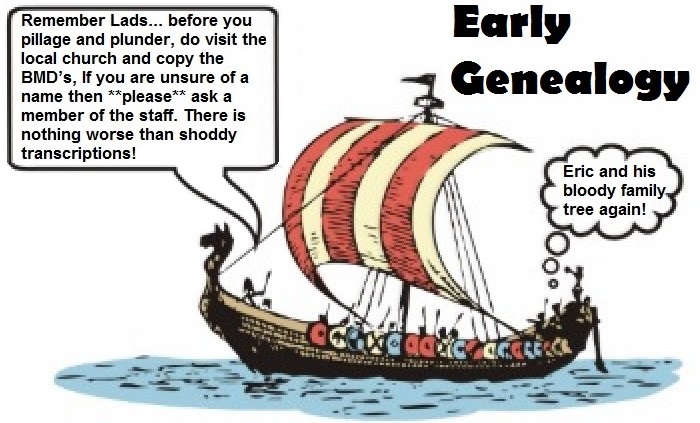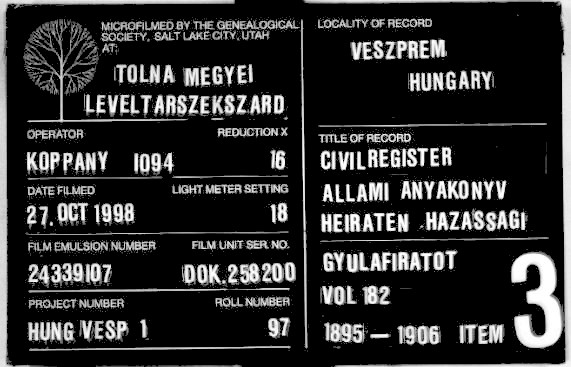|
The
|
THE BURGENLAND BUNCH NEWS - No. 255 May 31, 2015, © 2015 by The Burgenland Bunch All rights reserved. Permission to copy excerpts granted if credit is provided. Editor: Thomas Steichen (email: tj.steichen@comcast.net) Archives at: BB Newsletter Index Our 19th Year. The Burgenland Bunch Newsletter is issued monthly online. It was founded by Gerald Berghold (who retired from the BB in the Summer of 2008 and died in August 2008). |
Current Status Of The BB: * Members: 2345 * Surname Entries: 7603 * Query Board Entries: 5459 * Staff Members: 17 |
This newsletter concerns: 1) THE PRESIDENT'S CORNER 2) GEOMORPHOLOGY OF BURGENLAND (by Wilhelm Schmidt) 3) ALL I WANT FOR CHRISTMAS IS A DNA TEST (by Paul Zotter) 4) AUTOSOMAL DNA GENETIC GENEALOGY (by Richard Potetz) 5) FAMILYSEARCH.ORG SEARCH STRATEGIES 6) HISTORICAL BB NEWSLETTER ARTICLES: - 2005 BURGENLAND BUNCH STATISTICS 7) ETHNIC EVENTS 8) BURGENLAND EMIGRANT OBITUARIES (courtesy of Bob Strauch) |
1) THE PRESIDENT'S CORNER (by Tom Steichen)  Concerning
this newsletter, after the bits and pieces here in my "Corner," we entertain you with some deep
(both in time and in depth) Burgenland history, as Wilhelm Schmidt tells us about
the Geomorphology of Burgenland. Dig in and enjoy it! Concerning
this newsletter, after the bits and pieces here in my "Corner," we entertain you with some deep
(both in time and in depth) Burgenland history, as Wilhelm Schmidt tells us about
the Geomorphology of Burgenland. Dig in and enjoy it!Articles 3 and 4 are both DNA-related articles though each adds its own perspective. First, BB member Paul Zotter tells us about his initial experiences with DNA testing in an article entitled All I Want for Christmas is a DNA Test. That one is followed by Richard Potetz's more technical article, Autosomal DNA Genetic Genealogy. As a pair, they work well together since Paul's DNA test was of the autosomal variety. Article 5 is one I started some time ago concerning FamilySearch.org Search Strategies but set aside for various reasons. I figured I'd better publish it before the online tools change so much that these strategies are no longer relevant! The remaining articles are our standard sections: Historical Newsletter Articles, and the Ethnic Events and Emigrant Obituaries sections. Follow-up to 'Help With Nicknames': Last month, I ran a query sent in by BB Member Nancy Kern Sweeten. The questions were: What are the proper spellings of 'nicknames' Gite and Galtie, what are they derived from, and what relationship (if any) do they imply?  It
comes as no surprise to me that many readers were able to answer these questions. Among
responders were Sandy Schutzenhofer Richter, Christine Rubba, Wilhelm Schmidt, Peter Lang, Hanne
Billowitz, Bob Strauch, and Claudia Freiler. All agreed that the words derive from German;
all but one agreed they meant godfather and godmother; and no two of them
agreed on the 'proper' spelling! It
comes as no surprise to me that many readers were able to answer these questions. Among
responders were Sandy Schutzenhofer Richter, Christine Rubba, Wilhelm Schmidt, Peter Lang, Hanne
Billowitz, Bob Strauch, and Claudia Freiler. All agreed that the words derive from German;
all but one agreed they meant godfather and godmother; and no two of them
agreed on the 'proper' spelling!Some of the proposed spellings were: Goed and
Gauedl, Geid and Gaodl, Geid and Geidl, Göd and Godl,
Gejd/Gäid/Ge(i)d and Goudl/Goudi, and Ged and Godi/Godl.
|
2) GEOMORPHOLOGY OF BURGENLAND (by Wilhelm Schmidt) 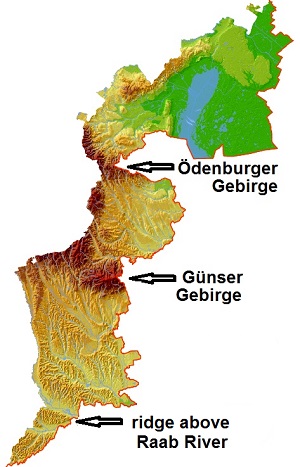 Geographically,
Burgenland has the appearance of a misshapen animal: a large head, a small chest, a sizable
abdomen and a tail. Its neck is only three miles wide, its waist ten and its rump five. At each
of the narrow parts, there is a mountain range or a ridge: at the neck the Ödenburger Gebirge
(Sopron Mountains), at the waist the Günser Gebirge (Köszeg Mountains), and at its rump
the ridge north of the Raab River (name unknown). The two mountain ranges are almost impassable.
Only a secondary road crosses the Ödenburger Gebirge, and a sinuous highway (literally a
high way, built after the creation of Burgenland) crosses the Günser Gebirge. The
mountains almost dismember the province. That was the intention of Hungary when it ceded the
land. Unable to prevent its loss, Hungary tried to choke and squeeze the new province to death
by depriving it of an arterial road connecting its parts. Geographically,
Burgenland has the appearance of a misshapen animal: a large head, a small chest, a sizable
abdomen and a tail. Its neck is only three miles wide, its waist ten and its rump five. At each
of the narrow parts, there is a mountain range or a ridge: at the neck the Ödenburger Gebirge
(Sopron Mountains), at the waist the Günser Gebirge (Köszeg Mountains), and at its rump
the ridge north of the Raab River (name unknown). The two mountain ranges are almost impassable.
Only a secondary road crosses the Ödenburger Gebirge, and a sinuous highway (literally a
high way, built after the creation of Burgenland) crosses the Günser Gebirge. The
mountains almost dismember the province. That was the intention of Hungary when it ceded the
land. Unable to prevent its loss, Hungary tried to choke and squeeze the new province to death
by depriving it of an arterial road connecting its parts.This historical travesty was aided by the natural structure of the territory, which came into being about 65 million years ago. The two ranges were formed at the same time as the Alps, but not by the same process. To understand their formation, we must go back to the time when all the continents were bunched together in the configuration called Pangaea. They were, however, divided into two parts—North America, Europe and Asia to the north and South America, Africa, Australia and Antarctica to the south—by a current flowing west to east, called the Tethys. A lesser current, called the Paratethys, flowed from the North Sea, across Germany and Hungary, all the way to the east end of Asia. Then, the tectonic plates underneath the continents began to shift. North and South America 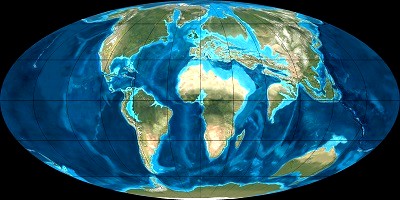 drifted
to the west, Australia southeast. Europe and Asia remained stuck together. Africa moved north
and pushed under the European plate, raising it to create the Alps. The Tethys
disappeared. But in its place, the Mediterranean Sea appeared. The northern part of the
African plate broke off, and water flowed from the western ocean into the gap. drifted
to the west, Australia southeast. Europe and Asia remained stuck together. Africa moved north
and pushed under the European plate, raising it to create the Alps. The Tethys
disappeared. But in its place, the Mediterranean Sea appeared. The northern part of the
African plate broke off, and water flowed from the western ocean into the gap.At the east end of the sea, the European, Asian and African plates interlocked. First, a section of the African plate broke off, drifted east—forming India—and slid under the Asian plate—creating the Himalayas. This section of the African plate was replaced by part of the Asian plate – now constituting Turkey, the Levant and the Arabian peninsula. While this happened, a chip of the African plate moved northward, rotated around the Moesian Massif (in western Bulgaria), continued in a westerly direction until it struck the Alpine up-thrust. Voila, the Günser Gebirge! Also the Ödenburger Gebirge and the high land between them, the Bucklige Welt to the west, and the South Burgenland Bulge (Punitzer Platte) to the south. At its point of contact with the Alpine plate, this chip pivoted and collided with the northern part of the European plate to form the Carpathian Mountains. Another piece of the European plate that had been sucked into the rotation locked the African chip in place. The line at which they meet—called the Periadric Seam—runs from the Raab River past the Plattensee (Lake Balaton) and Budapest. 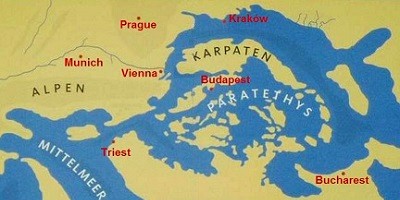 All
the while, the Paratethys continued to flow. It flowed through the gap between the
Vienna Woods and the Carpathians, across the Pannonian Plain into Asia. The
flow, however, diminished due to an uplift of land in northern Germany. It came to a halt when
mountain ranges formed in Mongolia. Cut off from its source and its outflow, it became an
immense inland sea, called the Pannonian Sea. Without a constant inflow, it began to dry
up about 7 million years ago. By 600,000 years ago, only large puddles of it remained: the
Black Sea, the Caspian Sea, the Aral Sea, and—closer to home—the Neusiedler
See. Only a trickle of the Paratethys remained: the Danube—still the longest
river in Europe. All
the while, the Paratethys continued to flow. It flowed through the gap between the
Vienna Woods and the Carpathians, across the Pannonian Plain into Asia. The
flow, however, diminished due to an uplift of land in northern Germany. It came to a halt when
mountain ranges formed in Mongolia. Cut off from its source and its outflow, it became an
immense inland sea, called the Pannonian Sea. Without a constant inflow, it began to dry
up about 7 million years ago. By 600,000 years ago, only large puddles of it remained: the
Black Sea, the Caspian Sea, the Aral Sea, and—closer to home—the Neusiedler
See. Only a trickle of the Paratethys remained: the Danube—still the longest
river in Europe.The collision of the African platelet with the Alpine plate created the highest point in Burgenland, the Geschriebenstein (named after a stone set at its top with writing on it, indicating the border between the dominions of the Eszterházy and the Batthyány families). Concomitant with its formation, land north of and south of the Günser Gebirge subsided. The land tilted toward the Neusiedler See and the Raab River Valley. The tilt accounts for the direction of the flow of the rivers in the region. The major river flowing north is the Leitha, and it flows into the Danube. No river or stream flows into the Neusiedler See. All the rivers and streams south of the Ödenburger Gebirge flow southeast into the Raab River. All the rivers south of the Günser Gebirge—notably the Zöbern, the Pinka, the Strem and the Lafnitz—flow south, and eventually into the Raab River. Its flows east out of the Alps, cuts off the tail of Burgenland, turns northeast upon entering the Pannonian Plain and discharges into the Danube. The river valleys—especially those of the southern part of Burgenland—were formed after the last ice age, which ended about 10,000 years ago. During the ice age, the Alps were glaciated and the area of the present Burgenland was probably tundra. When the glaciers melted, torrents of water flowed out of the Alps and eroded the land along its path. Over several thousand years, the courses of the rivers stabilized, and floods occurred only seasonally. As the flow of water slowed, the former stream beds turned into marshes. The courses of the rivers began to meander, and islands formed. I undertook the study of the geomorphology of the region to explain the southward flow of the Pinka in the Lower Pinka Valley and the formation of the one-time island of Pernau. As the Pannonian Sea dried up, the South Burgenland Bulge surfaced, and sandy particles from it were carried by the wind eastward, only to fall into the receding sea. They eventually formed a plateau of loess about sixty feet high, several miles wide, and extending south from the Günser Gebirge to the Raab River. The Pinka, flowing out of the Alps in a southeasterly direction, was unable to break through this sedimentary deposit, and was diverted southward. Since the drop in elevation along its southward path was minimal, it wound its way back and forth and frequently split up. 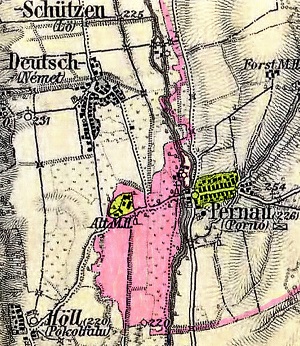 Not
far above the village of Pernau, a loop began, creating an island, not quite a square
mile in area, to the west and below the village. The loop has disappeared, probably though human
effort to prevent flooding of the Althof (old estate farm)—my father's birthplace and my
parents' first domicile. But signs of it—wetlands vegetation and the irregular shape, now the
border between Austria and Hungary—remain. Not
far above the village of Pernau, a loop began, creating an island, not quite a square
mile in area, to the west and below the village. The loop has disappeared, probably though human
effort to prevent flooding of the Althof (old estate farm)—my father's birthplace and my
parents' first domicile. But signs of it—wetlands vegetation and the irregular shape, now the
border between Austria and Hungary—remain.[Ed: In the 1870s-era map to right, the pink area is the likely region of the island. Its western border matches the western border of the 1870s Pernau hotter (land farmed by the village). The island, and the area to the right that is delimited by pink extension lines, which also follow 1870s hotter limits, are in current-day Hungary (the rest is current-day Burgenland). The Althof is marked "Alt M.H." (Alt Meierhof) and is shaded yellow, as is the village of Pernau. The 1870-era Pinka River is the dark, thick line running vertically down the map and to the right of the island. As for the loop, it was already gone by 1780, at least according to military maps of that era.] |
3) ALL I WANT FOR CHRISTMAS IS A DNA TEST (by Paul Zotter)  This
past Christmas, I was pleasantly surprised to receive an AncestryDNA autosomal DNA
kit as a present from our oldest daughter, Kate. She shares my curiosity about our ancestral
past and thought that this might open up new avenues, as I had hit the proverbial brick wall in
my research. This
past Christmas, I was pleasantly surprised to receive an AncestryDNA autosomal DNA
kit as a present from our oldest daughter, Kate. She shares my curiosity about our ancestral
past and thought that this might open up new avenues, as I had hit the proverbial brick wall in
my research.My genealogical journey began shortly after Thanksgiving of 2009. I had been visiting a close friend named Tom. In the course of our conversation he had mentioned that, when he had been in Austria several years before with his father and brothers visiting his relatives, he had visited a cemetery in St. Martin an der Raab and that there were “a lot of dead Zotter’s there.” He asked if I knew where my family might have emigrated from. This piqued my curiosity, as I really did not know and both of my parents were deceased. I went online the following day and, within an hour, had discovered the Burgenland Bunch and that I had a cousin linked in the Villages section to a place called Welten. I contacted my cousin, who had visited Welten 30 years earlier, but he had only met an elderly couple who resided at the family farm. They were related to my grandfather’s brother’s wife, but apparently not very helpful to him. I then began researching my Austrian genealogy via LDS microfilms and, over time, was able to trace my father’s Austrian grandparents back to the late 1700s. I also contacted other people whose email addresses were listed in the Burgenland Bunch Villages section that pertained to places that my relatives resided. In doing so, I made acquaintance with Richard Potetz, whom many of you may know from his enlightening articles and contributions to the monthly newsletters. We have corresponded often over the past 5 years and he had encouraged me to try DNA testing, as he felt we may be related since he had a Zotter in his genealogical line… which brings us up to the present. I contacted Richard to let him know that I was now going high tech. The next steps were to provide the saliva sample following the easy instructions, enter an activation code on the Ancestry website which identifies the sample, and then returning it to them in an addressed prepaid box. In the meantime, I created a family tree on Ancestry and waited for an email that it was received by Ancestry. From the point of receipt they stated it would take 6 to 8 weeks for the results. Within 3 weeks, however, I pleasantly received an email notification that my DNA results were available. In the email, one could click onto the "See My Results" button, which takes the user directly to the AncestryDNA site. Once there you could view your Ethnicity Estimate, which may or may not yield some surprises. When I was in elementary school, teachers would ask the class about their ethnic background, so I asked my mother and she told me, "tell them you’re German," which I did and assumed to be true. So, from that and my genealogical research, which showed that my father’s parents were both from the Burgenland region and my mother’s parents were German/French on her father's side and German/German on her mother's side, I assumed that it would be mostly Central European. My ethnicity was estimated as 34% Europe West (the German and French), 28% Europe East (the Austro-Hungarian), 12% Great Britain, 10% Scandinavian, 4% Ireland, 4% Iberian Peninsula, 4% Italy/Greece, 3% Finland/Northwest Russian and less than 1% Western Asia (which was stated as a possible anomaly). I could fairly well explain 62% of this, but the rest left some questions to be resolved... trips to the British Isles, holiday romances in the Mediterranean, and Nordic invasions came to mind. Fortunately, Ancestry has a nice feature, where the user can click on each ethnic group shown and it brings up the geographic and historic factors for that region as well as early migratory groups which inhabited that area, along with other ethnic groups that may be linked. This makes for interesting reading. In my case, the Celts who roamed northern Europe up to 2500 years ago may be the key to my other 38%, as they were moved in many directions by various invasions. But, then again, it may not be that simple, as most genealogy-related subjects never seem to be. Now, onto the good stuff: the DNA Results. After opening this portion of the website, the possible matches are listed in their most-likely sequence. In my case, 4th Cousins were the closest possible matches and these were rated as Very High confidence, of which 3 were listed. Following those, there were others listed as Distant Cousins (5th to 8th generation) that comprised almost 700 listings. These were rated sequentially from High to Good to Moderate by Ancestry's confidence level scheme for matches. There is a selection to View Match and this will display the Ethnicity of that match, as well as the ability to view their family tree if you are a current member of Ancestry and the tree is not locked by the user. It is a nice feature when you can view their tree and compare with your own. You also may send a message to that match within the Ancestry program, which is a nice feature. I composed a brief standard message that included all surnames of my relatives and their ethnicity, which I then copied and pasted into messages to my matches. If the match replies, it appears in my home email, which means you don't have to check within Ancestry all the time. However, I have found over a 3 month period of time that not all of messages appear to be received by the match, which I find to be disconcerting. In one instance, I sent 5 messages to certain user, who received none through Ancestry, but, when I sent an email to his personal address, which I had obtained from another DNA site, he replied and we were able to establish an actual connection through our correspondence. In the DNA Results, there are Filters that allow the user to show New matches that haven’t been viewed before and an ability to mark matches as Starred for whatever purpose necessary. I use it to denote folks who have responded to my inquiry message. In the Home Page Settings the user may set their email notifications to receive new matches by week, month or to turn it off, as well as link their DNA results to a family tree. There is also a feature called DNA Circles, which should display any person that is directly linked genetically to an ancestor in your family tree. There are also some nice search features that allow the user to search matches by surname and birth location, provided the match has a family tree listed. Another has a search by date and relationship. Ancestry packages a very attractive product and has a lot of useful help-related processes included with it. They are also beginning to branch their DNA testing program into Great Britain and Ireland. The AncestryDNA test is $99, which is the lowest priced of the 3 major DNA testing sites; 23andMe, and FamilyTreeDNA are the others. The user has to realize that Ancestry is also selling subscriptions to its data and, at this time, a US-only membership is $19.99 per month, or 6 months for $99.00. The World membership is $34.99 or 6 months for $149.00. To access the family trees of your matches, you need one of these memberships. They occasionally run specials with discounted prices for DNA testing and memberships. By the way, if you ever use their 14-Day Free Trial, specify that you want the World membership; otherwise you will get the US-only membership and its limited search capacity. Besides the membership costs, a few other negatives with Ancestry are that they do not save the DNA sample that is submitted. Should the DNA file they have be deleted by the user inadvertently or by Ancestry, another one would need to be submitted. When I initially viewed the next 6 paragraphs on the Ancestry web site, it concerned me that AncestryDNA's testing method might be severely limited. Upon further investigation I discovered that all the other DNA autosomal tests have a similar limitation. Here are the 6 paragraphs (indented section):
The user must realize that, due to the nature of autosomal inheritance, the reliability of
the testing at or above the 4th generation appears to be questionable. Rather than attacking
this "small-print" claim, the broader complaint might be with Ancestry's claim that one
can accurately discover distant relatives using this service. Most importantly, one should
understand that autosomal DNA has its limitations, and researching the different DNA vendors and
tests might be in your best interest depending on what or who you are actually looking for. |
4) AUTOSOMAL DNA GENETIC GENEALOGY (by Richard Potetz) 23andMe, FamilyTreeDNA, and AncestryDNA all compete for autosomal DNA testing business. I received 23andMe testing as a gift. For an additional charge, FamilyTreeDNA included my 23andMe raw DNA results in their Family Finder program so I can find relatives tested by either company. (That option is no longer available because 23andMe has changed to a non-compatible test.) My FamilyTreeDNA list of relatives is tiny, just 34 people. Friends using either 23andMe or AncestryDNA have found third and fourth cousins. The Food and Drug Administration ended the health portion of information provided by 23andMe, fearing people without medical training would misinterpret their results. Most of us know the heath issues of our ancestors. For adoptees and others who do not know their ancestors' health problems, testing is their only source of hereditary medical information. Hopefully, health-related DNA test results will become available again soon. 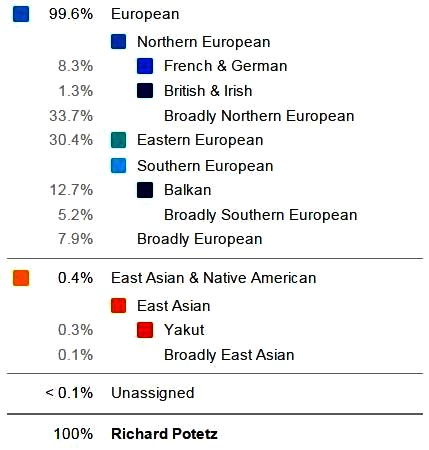 One
way of looking at the location of your ancestry comes from the elements of your DNA that are
associated with a particular place. Here’s what 23andMe has to say about their tool
called Ancestry Composition: One
way of looking at the location of your ancestry comes from the elements of your DNA that are
associated with a particular place. Here’s what 23andMe has to say about their tool
called Ancestry Composition:“Ancestry Composition tells you what percent of your DNA comes from each of 31 populations worldwide. The analysis includes DNA you received from all of your ancestors, on both sides of your family. The results reflect where your ancestors lived 500 years ago, before ocean-crossing ships and airplanes came on the scene.” In order of DNA amount (see image to the right), Ancestry Composition shows me to be mostly Northern European, next Eastern European, and then Southern European. The Northern European DNA that could be associated to a more-specific location was mostly from France/Germany (France and Germany are grouped in this study). The Southern European DNA came from the Balkan countries. A tiny bit of non-European DNA came from the Yakut people of Siberia. No part of these results is surprising based on my known ancestors and the history of their location. 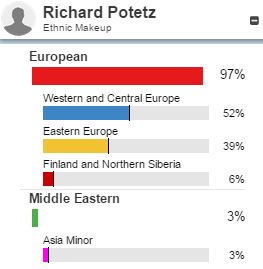 FamilyTreeDNA’s
myOrigins tool is similar, but uses larger groupings than the 23andMe
Ancestry Composition tool with its 31 categories. Also the lines are drawn differently so
they are hard to compare, but appear to be consistent. My myOrigins results are shown to
the right. FamilyTreeDNA’s
myOrigins tool is similar, but uses larger groupings than the 23andMe
Ancestry Composition tool with its 31 categories. Also the lines are drawn differently so
they are hard to compare, but appear to be consistent. My myOrigins results are shown to
the right.Our autosomal chromosomes came to us from our ancestors though a random selection mixing process. A one-minute video picturing this process is found at: http://learn.genetics.utah.edu/content/chromosomes/typesauto/. Unlike autosomal DNA testing, other DNA testing can connect you to relatives who lived before recorded history. Testing of the Y-chromosome (Y-DNA) passed from father to son is useful for identifying males related thousands of years ago. The Y-chromosome does not undergo all of the random selection that autosomal chromosomes endure at each generation. A one-minute video picturing Y-chromosome father-to-son linking is found at: http://learn.genetics.utah.edu/content/chromosomes/typesy/. Mitochondrial DNA (mtDNA) also passes without mixing, from mother to offspring. Thus a chain of female ancestry can identify descendants of a female who lived thousands of years ago. A one-minute video picturing mtDNA mother-to-child linking is found at: http://learn.genetics.utah.edu/content/chromosomes/typesmito/. Interestingly, the X-chromosome (X-DNA), typically included with autosomal results, has its own unique inheritance pattern. See video http://learn.genetics.utah.edu/content/chromosomes/typesx/. We can learn of ancient origins. 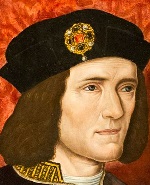 Frank
Paukowits has written in the Burgenland Bunch Newsletter of Y-chromosome test results
used to establish the ancient origin of immigrants to Burgenland. Likewise, the remains of King
Richard III, discovered in 2012, were identified using mtDNA testing. Living matrilineal
descendants of his sister, Anne of York, were tested to confirm his identity. Richard died in
1485, too long ago for autosomal DNA testing to be helpful. Random recombination
occurring at each generation divides autosomal DNA into sections too short for positive
identification after five to eight generations. Full details on the identification of the
remains of Richard III can be seen at
www.nature.com. Frank
Paukowits has written in the Burgenland Bunch Newsletter of Y-chromosome test results
used to establish the ancient origin of immigrants to Burgenland. Likewise, the remains of King
Richard III, discovered in 2012, were identified using mtDNA testing. Living matrilineal
descendants of his sister, Anne of York, were tested to confirm his identity. Richard died in
1485, too long ago for autosomal DNA testing to be helpful. Random recombination
occurring at each generation divides autosomal DNA into sections too short for positive
identification after five to eight generations. Full details on the identification of the
remains of Richard III can be seen at
www.nature.com. But mtDNA and Y-DNA testing excludes most of our ancestors. Just direct male and female lineages are involved. Another option in looking for your oldest origins is the National Geographic Genographic 2.0 test, which includes mtDNA, Y-DNA and autosomes. For many people, autosomal DNA testing can assist conventional genealogy. Perhaps a 'bit of spit' will bring more gratification to your genealogy hobby. [A chart comparing Autosomal DNA testing services can be found on the site of the International Society of Genetic Genealogy: http://www.isogg.org/wiki/Autosomal_DNA_testing_comparison_chart.] |
5) FAMILYSEARCH.ORG SEARCH STRATEGIES This is an article I started some time ago but then set aside as other, more pertinent subjects occupied my time. Recently, I came back to the article and added some paragraphs on items I remembered I had intended to write about. While I doubt I covered everything I had once hoped to cover, the article is already quite long and I've decided that it is best to publish it now before the included advice become obsolete; please forgive its somewhat abrupt ending! Recently, BB member Vicky Weninger was searching for family members in Rátót, Hungary (along with other family lines within Burgenland). She was not making any headway, so she asked for help... and I was able to provide quickly numerous records relating to her search. However, she replied back: "If I may ask, where did you get these records. I punched in the name under Family Search and I came up empty." Truth be told, when I did the same, I came up empty too! Nonetheless, by knowing a lot about the weaknesses of the FamilySearch.org index search program—and the ways around those weaknesses—I was able to force it to cough up the desired records. So, this is an article about search strategies: how to use the tools available to most effectively find the information you desire. Sometimes, merely typing in the name of interest suffices, but not always. I will use Vicky's search as my demo, though I will not start immediately with the FamilySearch.com index search program. However, many of the strategies I'll mention while working with other tools apply to the index search tool also. Let's get started... The emigrant couple that Vicky was interested in was Georg Wenninger and Elisabeth Nemeth. Based on the info Vicky had, we knew that George was born in 1879 in "Ratot, Vezprem, Hungary," Elisabeth in 1886 in "Vesprem, Hungary" and that they emigrated in 1904 and also married in 1904 in Bethlehem, PA. We also knew that George's parents were Josef and Elizabeth (Stumphauser) Wenninger, born approximately 1848 and 1852, respectively, in Hungary. That is actually a lot of information, and it would allow us to easily confirm that we had found the right people if all this matched up. Note, though, that the two Hungarian partial locations provided, Vezprem and Vesprem, differ from each other and, in reality, from the proper spelling: Veszprém. Interestingly, Veszprém (spelled right) is both a city and a county in Hungary... but what is meant by Vicky's notation remains to be discovered; we'll keep an open mind. To confuse things further, there are two Rátóts in Hungary; one Rátót is in Vas Megye, Hungary, a few miles south of Heiligenbrunn in Burgenland. This Rátót is also known by the German name of Neustift. The other Rátót is some distance away in Veszprém Megye, just northeast of the town of Veszprém; it is known variously as Gyulafirátót, Rátóth and Rátót. While we did not know initially which was the right Rátót, it turned out to be the second one (how we discovered that is not relevant to the point of this article, though it was confirmed by the records we eventually found). Here is the first search strategy: Start with the most recent information you have and work backward. While this article is really about manipulating the search engine at FamilySearch.org, our most recent data is the 1904 emigration and marriage, so that is where we should start. However, 1904 US marriage records are usually very difficult to find so I chose to concentrate on the emigration of the same year, mostly because emigration through Ellis Island seemed most likely and the ability to find people in the Ellis Island database is excellent; that expectation, however, was quickly dampened by reality: I plugged "Wenninger" into the Ellis Island search box and found no George. As I've said before, Stephen Morse's One-Step Tools are a far more efficient way to search the Ellis Island database (see Newsletter 219, article 4 for details), so I jumped over there and plugged "Ratot" into the "Town Name" box, left everything else blank, and hit "Search". It returned 328 records of people who came from a "Ratot" and emigrated through Ellis Island. Adding "1904" in the "year of arrival" box reduced this list to 31 names... none of which was Wenninger. However, the list was short enough to easily scan and I quickly noted a Georg Heninger, born 1879 ...and right next to him was an Elisabeth Heninger, born 1886. These birth years matched, and I knew enough about the foibles of transcribing old writing that I could easily imagine a script W being interpreted as an H. So I pulled up the scan of the ship manifest and quickly confirmed that it was, indeed, a W mistranscribed as an H. This gets us to search strategy #2: Do not assume the name is spelled in old records as you spell it today; further, do not assume a transcriber will read/interpret correctly the hen-scratching on an old record. So, if possible, use other, general information to "sneak up" on the record of interest. While I was working in the Ellis Island database here, the problem of misspelled and mistranscribed names occurs frequently in the FamilySearch index too. One way around that is to do general searches using the village (or recording place—they are not always the same; however, it is the recording place, not the village, that is in the database when they differ). So here I used the village name, further reduced by adding the appropriate year, to quickly find a record that was both mistranscribed and misspelled (at least based on the modern-day expectation of what the spelling was). The ship manifest pointed out a number of useful things... one of which relates to my next search strategy... did you see it? Elisabeth was recorded with surname [H/W]eninger, not Nemeth, as she should have been if they were married in 1904 in Bethlehem, PA. A quick look at the "marriage/single" column of the manifest, indicated that they were, in fact, married, so the claim that they were married in Bethlehem, PA, was wrong. Third search strategy: Do not assume that everything you "know" is exactly correct; assume, instead, it is approximately correct. So, for example, when possible use a range of years around the event date you "know." As it turns out, George and Elisabeth were married in 1904... but in Rátót about a month before emigrating. My experience has been that "family lore" is often only approximate, with even critical dates, such as those for births or marriages, being off by days or even years. Nonetheless, that same lore will have some underlying truth to it that will often reveal itself only once you learn enough to see it, so do not discard it! Fourth search strategy: Read, save and use everything on each document. In this case, the manifest notes a number of useful things: 1) George and Elisabeth were going to George's brother John Weninger in "Lehigh Gap, PA, near Palmerton, PA"; 2) George was in Lehigh Gap previously, from 1902-1904; and 3) Elisabeth was only 18 years old. Item 1 gives us another verifiable fact, that George has a brother John, so we should be able to find him in the available church records (and doing so will help confirm we have the right family). Item 3 made the search for their marriage record much easier (as young as she was, I started from the emigration date and worked backward... bing! ...but more on that later). Item 2 also hinted that the marriage record would be in a narrow gap, as George was in America in early 1904. The "Lehigh Gap, PA, near Palmerton, PA" was an interesting (though not particularly useful) factoid... Bethlehem, PA (the place where both George and Elisabeth died and where it was thought the marriage took place) is in Lehigh County and the Lehigh River runs through it, so the name was at least consistent with known facts. However, a Google Maps search for Lehigh Gap, PA, returns nothing but a geological feature: the gap where the Lehigh River cuts through the long ridge that defines the northern reach of the Lehigh Valley. It is 15-20 miles northwest of Bethlehem, and Palmerton is the first town on the other side of the gap. Thus it is not inconsistent that the couple would have ended up in Bethlehem, even though they started out in Lehigh Gap... but the researcher in me wonders why they went there (did he help widen the gap for the railroad and highway that now passes through it? The 4-lane highway and the railroad are still there but the more recent I-476 goes through a tunnel under the ridge about a mile west). It could be an interesting topic for Vicky to pursue. So, let's make the jump to FamilySearch.org and continue our search. Now that we know that the marriage took place in Hungary and (almost certainly) in 1904, let's start with that. As you may recall, microfilmed church records typically run from 1828 (because that is when the Hungarian government made churches responsible for recording vital records and required they share a copy with the government) and 1895 (because that is when the government transferred the responsibility for recording vital events to the local civil authorities, who also had to share a copy with the national government). FamilySearch indexed many of the church records and they are searchable online. Civil records (for Burgenland) typically run from 1895 until 1921, when Hungary transferred recording responsibility to Austrian-controlled authorities. The Hungarian-controlled civil records are available both on microfilm and digital images via FamilySearch.org, but very few have been indexed. If you want to consider it a search strategy, my strategic advice is do not waste your time searching in the FamilySearch index for events that took place in Burgenland between 1895 and 1921! They won't be indexed. But, since the marriage of interest almost certainly took place in 1904, it should appear in the civil records and the digital image of it should be available at FamilySearch.org. The search must be a manual, page-by-page, digitally-flipping-through-the-appropriate-marriage-book exercise. Nonetheless, you want to do this! The marriage record will confirm birth dates and locations and provide the names and current residence of the parents (plus it is a neat record to have!). As for strategies for working in the civil digital images, there are some that are worthwhile. First, save a bookmark for the record collection of interest to you. You will go there often and a one-click entrance beats going through all the steps over and over again. They will be big ugly long things, like this one for Rátóth, Veszprém, Hungary: https://familysearch.org/search/image/index#uri= https%3A%2F%2Ffamilysearch.org%2Frecapi%2Fsord%2Fwaypoint%2FM8PL-X3X%3A40679901%2C51273901%3Fcc%3D1452460 but the length will not matter once stored in you bookmark under a sensible, short name. Going there will display a page with all the record sets in the collection:
Here is another strategy for the civil records: Do not assume that the date ranges
in these labels are correct. Verify them! |
6) HISTORICAL BB NEWSLETTER ARTICLES Editor: This is part of our series designed to recycle interesting articles from the BB Newsletters of 10 years ago. One of the articles from May of 2005 was written by me (when Gerry was still NL Editor and I was Surnames Editor) commenting on one of the membership statistics Gerry reported monthly in the newsletter. I'll repeat that 2005 article and then give you a 2015 update and comparison to the 2005 numbers. Here goes... THE BURGENLAND BUNCH NEWS - No. 140 May 31, 2005 BURGENLAND BUNCH STATISTICS (from Tom Steichen, BB Surname Editor) Tom writes: I noted in the latest newsletter that you show, as part of the "Current Status Of The BB," that there are 4,296 "Surnames Listed," a number I'm sure you pulled directly from the BB Surnames pages I edit. While there are certainly 4,296 surnames listed on my site, perhaps this might be better stated as "Surname entries," as there are not that number of unique surnames. In fact, a quick and crude assessment shows that there are nearly 2,000 exact duplicate names among those 4,296 entries, leaving only about 2,300 uniquely spelled entries. Among those 2,300, perhaps a quarter to a third are slight spelling variations. Thus, my guess is we list about 1,600-1,900 unique Surnames for our 1,200 members. None of the above numbers should be considered negative in any way; rather, they provide different types of information. The first one, a total of 4,296, lets us know that our members list, on average, about 3.5 entries each. The second one, 2,000 duplicates, suggest that there is likely to be significant ancestral relationships among our members (and that they can be of help to each other); it also suggests, unsurprisingly, that there must have been, within the Burgenland, many names in common, though families were unrelated (job-related titles come to my mind immediately). The large number of spelling variations is no surprise either, as all of us in genealogy know it is foolish to assume a name moved through time (or across the waters) without any changes... and this helps make that point well. The last numbers... 1,600-1,900 unique names may be the biggest surprise! That our 1,200 members have sprung from such a diverse family tree from such a small region in Europe is amazing! I suspect it will only expand when I process the next batch of emails awaiting addition to the pages. Tom Steichen, BB Surnames Editor May 2015 Update and Comparison: The BB Surnames pages contain 7597 [4296] surname entries (where [4296] is the 2005 number from the above article). After elimination of exact duplicates, the surnames count reduces to 3821 [~2300]. Removal of obvious spelling variations then reduces the numbers to 2600-2900 [1600-1900] unique surnames. We report 2337 [1200] members, which says, on average, members report 3.25 [3.5] surnames each. The difference between surnames reported and unique surnames is almost 5000 [~2370] shared names, again implying a large overlap and likely significant ancestral relationships among our members. If there is a surprise in comparing 2015 numbers to 2005 numbers, is that the percentage of unique surnames to total listed surnames, 32% in 2015 versus 41% in 2005, has not fallen more than it has as we nearly doubled the number of members during that time. That means that our newer members are adding unique surnames at nearly the same pace as the earlier members did... especially if that difference is also driven in part by the reduction in number of listed surnames/member, making it less likely that unique surnames are listed. |
7) ETHNIC EVENTS LEHIGH VALLEY, PA Sunday, June 7: Parish Picnic at Queenship of Mary Catholic Church in Northampton (formerly Our Lady of Hungary). Music by the Josef Kroboth Orchestra. Info: (610) 262-2227. Friday, June 12: Wurstfest at the Reading Liederkranz. Entertainment by Kermit Ohlinger. Info: www.readingliederkranz.com Friday & Saturday, June 19-20: Sommerfest at the Lancaster Liederkranz. Entertainment by the Hank Haller Orchestra, the Walt Groller Orchestra, and club folk dancers and singers. Info: www.lancasterliederkranz.com Saturday, June 20: 100th Anniversary Celebration at the Holy Family Club in Nazareth. Music by the Josef Kroboth Orchestra. Info: www.holyfamilyclub.com Saturday, June 27: Polka Mass at St. Francis of Assisi Catholic Church in Allentown. 4 PM. Music by the Emil Schanta Band. Info: www.stfrancisallentown.org Sunday, June 28: 98th Stiftungsfest at the Coplay Sängerbund. Choral concert with the Coplay Sängerbund Chorus, the Hianz’nchor, and guest choruses. Music for dancing by the Emil Schanta Band. Info: www.coplaysaengerbund.com NEW BRITAIN, CT Friday, June 5, 7 pm: Heimat Abend. Austrian Donau Club, 545 Arch Street, $3. Music by Joe Rogers and his band. Friday, June 19, 7:30 pm: Heurigan Abend. Austrian Donau Club, 545 Arch Street, $3. Music by Schachtelgebirger Musikanten. |
8) BURGENLAND EMIGRANT OBITUARIES Gizella Sauerzopf (née Magdits)  Gizella
Sauerzopf, 102 of Wayne, New Jersey, formerly of Clifton, passed away on April 24, 2015. She was
the beloved wife of the late Stephen Sauerzopf. Gizella
Sauerzopf, 102 of Wayne, New Jersey, formerly of Clifton, passed away on April 24, 2015. She was
the beloved wife of the late Stephen Sauerzopf.Born in Punitz, Austria, to the late Karl and Hedwig (Horvath) Magdits, Gizella came to the United States in 1929, settling in Passaic, She lived in Clifton for many years before moving to Wayne. She worked as a spinner at Fortsmann Woolen Mills in Garfield. She was a parishioner of St. Andrew the Apostle RC Church in Clifton and a former member of the Burgenländer-American Benefit Society; she was also a member of the 39'ers Senior Group of St. Andrew's RC Church in Clifton. Survivors: several nieces and nephews. She was predeceased by four sisters and three brothers. Services: Funeral from the Marrocco Memorial Chapel, 470 Colfax Avenue, Clifton on Friday at 9:15 AM followed by a Funeral Mass at St. Andrew the Apostle RC Church at 10 AM. Interment Calvary Cemetery. Visiting Thursday 4-8 PM. www.marroccos.com Published in The Record on Apr. 30, 2015 Julius Seifner  Julius
Seifner passed away peacefully on April 30, 2015 at the Norwood Extended Care Hospital,
Palliative Unit in Edmonton, Alberta, Canada. Julius
Seifner passed away peacefully on April 30, 2015 at the Norwood Extended Care Hospital,
Palliative Unit in Edmonton, Alberta, Canada.Born on April 29, 1930 in Glashütten, Burgenland, Austria, he was a son of the late Julius and Hermine Seifner. He is survived by his wife of 62 years, Maria; children, Christine, Gerhard (Rosangela) and Tina (Ron); grandchildren, Vanessa (Rick), Megan (Jon), Daniel (Kerry), and Ciara; great- grandchildren, Thomas, Sofia and Maria; sister, Elfie; brother, Walter; sister-in-law, Inge (Harold); as well as numerous nieces, nephews and good friends in Canada and Austria. Julius was predeceased by his parents and grandson, Christian. The family wishes to thank the medical team and staff at the Norwood and Royal Alexander Hospital, especially Unit 43. A Service of Remembrance will be held on Wednesday, May 6, 2015 at 10:00 a.m. at Memories Funeral Home, 13403 St. Albert Trail, Edmonton, AB. In lieu of flowers, donations in Julius' memory may be made to University Hospital Foundation, Brain Centre Campaign for Brain Trauma, 8440-112 St., Edmonton, AB, T6G 2B7 or Capital Care Norwood Hospice, 10410-111 Ave, Edmonton, AB, T5G 3A2. To send condolences to the family, please visit www.memoriesfuneral.com "He left us when the birds of summer returned." Published in The Edmonton Journal on May 4, 2015 Maria Schroettner (née Motzer)  Maria
Schroettner, 91, formerly of Wind Gap, passed away on Wednesday, May 06, 2015, at her daughter's
residence in Moore Township, Pennsylvania. Maria
Schroettner, 91, formerly of Wind Gap, passed away on Wednesday, May 06, 2015, at her daughter's
residence in Moore Township, Pennsylvania.She was the wife of the late John Schroettner with whom she shared 62 years of marriage prior to his death in 2004. Born in Rábafüzes (Raabfidisch), Hungary on November 28, 1923, she was a daughter of the late Barbara (Motzer) Ehasz and Gustav Kantz. A member of the International Ladies' Garment Workers' Union, Maria was employed as a sewing machine operator in the garment industry for 32 years before retiring in 1985. Earlier, she worked in an iron factory in Hungary, which produced swords. Maria enjoyed gardening, knitting, cooking and baking, and she loved and cherished her family, especially her grandchildren and great-grandchildren. Survivors: She is survived by her loving daughter, Heide Thomma with whom she resided; two sons, John Schroettner and his wife, Danielle of Hawaii and Helmut Schroettner and his wife, Deborah of Bethlehem Township; eleven grandchildren; twenty-four great-grandchildren; three sisters, Margaret Deiork and her husband, Vilmos, Ilona Schmidt and her husband, and Anna Zink and her husband, Bela, all of Hungary; a step-sister, Hilda Graf of Frackville; two step-brothers, Gustav Kantz and his wife, Margaret and William Kantz and his wife, Inge both of Allentown; many nieces and nephews. In addition to her late husband, John, she was preceded in death by a son, William Schroettner in 2000, three grandsons, two brothers, Steven and Leslie Ehasz, a stepbrother, Rudolph Kantz and a stepsister, Ella Edola. Services: will be held on Monday, May 11, 2015, at 1:00 P.M. in the George G. Bensing Funeral Home, Inc., 2165 Community Drive, Route 946, Village of Moorestown - Bath, PA 18014. Friends and relatives are invited to call on Monday morning from 12:00 Noon to 1:00 P.M. in the funeral home. Interment will follow in Mountainview Cemetery, Emanuelsville. Contributions: in lieu of flowers, may be made in memory of Maria to Heartland Hospice, 881 Marcon Blvd., Unit 3700, Allentown, PA 18109. Published in Morning Call on May 8, 2015 Theresia Frisch (née Wagner)  Theresia
Frisch, 87, of Clifton, New Jersey, passed away Monday, May 18, 2015 at Hospice of NJ, Wayne,
NJ. Theresia
Frisch, 87, of Clifton, New Jersey, passed away Monday, May 18, 2015 at Hospice of NJ, Wayne,
NJ.Born to the late Richard and Maria (Jandrisevits) Wagner in Northampton, Pennsylvania, she grew up in Kroatisch Tschantschendorf, Austria and resided in Clifton for 58 years. She was a production worker at Smith Kline Beecham, Clifton for many years before retiring. Mrs. Frisch was a very active parishioner of Holy Trinity R.C. Church, Passaic where she was a member of the Golden Agers. Survivors: daughters, Diane Wright of Clifton and Maryann Cushman and her husband, Paul of Montclair; sister, Mary Jandrisevits of Lincoln Park; grandchildren, Robert Turcic, Lisa Turcic, Daniel Cushman and Anne Cushman; and great-grandchildren, Ashley Jourdain, Nicholas Jourdain and Brianna Rivera. In addition to her parents, she was also predeceased by two brothers, Richard Wagner and Ernst Wagner; and two sisters, Pauline Wagner and Poldi Wagner-Seiler. Funeral Services are 10:15 AM Friday at Bizub-Quinlan Funeral Home, 1313 Van Houten Ave., Clifton and 11 AM at Holy Trinity R.C. Church, corner of Hope Ave. and Harrison St., Passaic. Entombment to follow at Calvary Cemetery, Paterson. Visiting Hours Thursday 4-8 PM. Please visit www.bizub.com for online condolences and driving directions. Published in The Record on May 20, 2015 Joseph Geiter  Joseph
Geiter, 73, of Bath, Pennsylvania, passed away on Tuesday, May 19, 2015, at St. Luke's Hospital
in Bethlehem. Joseph
Geiter, 73, of Bath, Pennsylvania, passed away on Tuesday, May 19, 2015, at St. Luke's Hospital
in Bethlehem.He was the husband of Felicia (Giobbi) Geiter. They celebrated 51 years of marriage this past October. Born on February 21, 1942, in Fertorákos (Kroisbach), Hungary, he was a son of the late Joseph and Katharina (Ivanschitz) Geiter. He immigrated to the United States in 1950. Joseph served in the United States Navy, patrol Squadron 26 from 1960-1964. Joseph worked for the former Bell Telephone for over 35 years. He was a member of Holy Ghost Catholic Church in Bethlehem, and is a 1960 graduate of Bethlehem Catholic High School. He was an avid outdoorsman, who enjoyed hunting and fishing, and enjoyed teaching his children and grandchildren how to respect nature. He was a life member of the NRA, and a member of the Queen City Police Combat League, but his passion in retirement was his membership in the Single Action Shooting Society (SASS). Survivors: He will be lovingly remembered by his wife, Felicia, sons, Christopher Geiter (Arlene), and Philip Geiter (Lee), daughter, Karen Martin (Kent), brother, Matthias Geiter (Sandra), and grandchildren, Megan, Alison, Erin, Madison, and Nathan. He was predeceased by a brother Herman Geiter. Services: Prayer services will be held 11 am Saturday May 23, 2015 at the Connell Funeral Home 245 E. Broad St. Bethlehem, Pa. followed by a Mass of Christian Burial 11:30am at Holy Ghost Catholic Church 417 Carlton Ave. Bethlehem, Pa. 18015. A viewing will be held from10-11am at the funeral home. Burial will be held at Holy Ghost Cemetery. Contributions: In lieu of flowers contributions may be made to St. Luke's University Health Network Development Office (Compassionate Fund) 801 Ostrum St. Bethlehem, Pa. 18015. Send online condolences to www.connellfuneral.com Published in Morning Call on May 22, 2015 |
| END OF NEWSLETTER |
NOTICE (Terms and Conditions): The Burgenland Bunch (BB) was formed and exists to assist Burgenland descendants in their research into their heritage and, toward that end, reserves the right to use any communication you have with us (email, letter, phone conversation, etc.) as part of our information exchange and educational research efforts. • If you do not want your communication to be used for this purpose, indicate that it is "confidential" and we will abide by that request. • Correspondents who communicate with the BB without requesting confidentiality retain their copyright but give a non-exclusive license to the BB allowing us to forward to BB members, publish in our monthly newsletter or on our website, and/or subsequently and permanently archive all or parts of such communications. The Burgenland Bunch homepage (website) can be found at: http://www.the-burgenland-bunch.org Burgenland Bunch Newsletter, copyright © 2015 by The Burgenland Bunch All rights reserved. Permission to copy excerpts granted if credit is provided. |
 News
News Church
Names: I mentioned that I had started a campaign a few months ago to identify all
church/temple/synagogue names in Burgenland. This month, Dr. Peter Lang provided church names
for three border villages, Raabfidisch / Rábafüzes (Dreifaltigkeits Kirche;
Szentháromság templom; Holy Trinity Church), Oberradling / Felsörönök (Sankt
Emmerich Kirche; Szent Imre templom; Saint Emerich Church), and Sanktgotthard /
Szentgotthárd (Mariä Himmelfahrt Stiftskirche; Nagyboldogasszany templom;
Saint Mary Assumption monastery church). He also provided one correction, Heiligenkreuz im
Lafnitztal / Rábakeresztúr (Pfarrkirche zur Kreuzerhöhung; Exaltation of the
Cross parish church). Do write if you can provide (or correct) any such names.
Church
Names: I mentioned that I had started a campaign a few months ago to identify all
church/temple/synagogue names in Burgenland. This month, Dr. Peter Lang provided church names
for three border villages, Raabfidisch / Rábafüzes (Dreifaltigkeits Kirche;
Szentháromság templom; Holy Trinity Church), Oberradling / Felsörönök (Sankt
Emmerich Kirche; Szent Imre templom; Saint Emerich Church), and Sanktgotthard /
Szentgotthárd (Mariä Himmelfahrt Stiftskirche; Nagyboldogasszany templom;
Saint Mary Assumption monastery church). He also provided one correction, Heiligenkreuz im
Lafnitztal / Rábakeresztúr (Pfarrkirche zur Kreuzerhöhung; Exaltation of the
Cross parish church). Do write if you can provide (or correct) any such names. BB
HouseLists and Other Projects: The core of an important BB project was completed in May.
This project is what we call the BB HouseLists. The HouseLists are
transcriptions of the 1856-1858 Burgenland land register records found in the
Österreichisches Bundesamt für Eich- und Vermessungswesen Katastral mappenarchiv. For a few
villages where the 1856-58 records were not available, we substituted Hungarian records from the
1910-1911 period. A very few villages have lists from additional periods. The lists generally
consist of the names of property-owning heads-of-households in the village, though sometimes
they include additional information such as spouse names, house names, or social status
information.
BB
HouseLists and Other Projects: The core of an important BB project was completed in May.
This project is what we call the BB HouseLists. The HouseLists are
transcriptions of the 1856-1858 Burgenland land register records found in the
Österreichisches Bundesamt für Eich- und Vermessungswesen Katastral mappenarchiv. For a few
villages where the 1856-58 records were not available, we substituted Hungarian records from the
1910-1911 period. A very few villages have lists from additional periods. The lists generally
consist of the names of property-owning heads-of-households in the village, though sometimes
they include additional information such as spouse names, house names, or social status
information.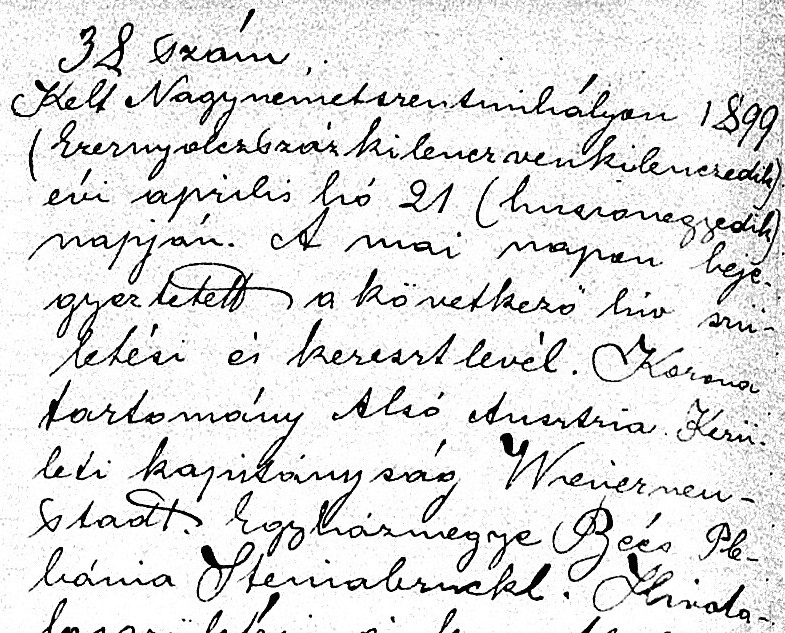 The
note that caught my eye was of the second type and the bit of text my eye settled on was
Steinabruckl! Ah-hah! I figured I found Henry! However, as I struggled through the first
part of the text, it seemed to be about a child named Emma... what a let-down! But, reading
further, the parents listed matched those of Hedwig and Henry! With help from Joe Jarfas to
confirm what I thought I was seeing, we learned that Emma was born 9 Feb 1897 and died 2 Mar
1897, both events occurring in Steinabrückl [which explains why Harry did not know about this
sibling]. It seemed, indeed, that this Steinabrückl was the one associated with the
Wukits family. That prompted me to keep looking and eventually (2 1/2 years further into the
records after Henry's birth) I found an inserted side note for him, which clearly gave
Steinabrückl as birth and baptism location and again tied the family back to Miedlingsdorf.
The
note that caught my eye was of the second type and the bit of text my eye settled on was
Steinabruckl! Ah-hah! I figured I found Henry! However, as I struggled through the first
part of the text, it seemed to be about a child named Emma... what a let-down! But, reading
further, the parents listed matched those of Hedwig and Henry! With help from Joe Jarfas to
confirm what I thought I was seeing, we learned that Emma was born 9 Feb 1897 and died 2 Mar
1897, both events occurring in Steinabrückl [which explains why Harry did not know about this
sibling]. It seemed, indeed, that this Steinabrückl was the one associated with the
Wukits family. That prompted me to keep looking and eventually (2 1/2 years further into the
records after Henry's birth) I found an inserted side note for him, which clearly gave
Steinabrückl as birth and baptism location and again tied the family back to Miedlingsdorf. FamilySearch.org
Record Additions: On May 8, FamilySearch.org announced the addition of more than 9.8
million index entries and document images to their already massive collection. Perhaps the most
notable update from the BB perspective is the addition of nearly 3 million index entries to the
Croatia Church Books, 1516–1994 collection. Other additions include 40,000 index entries to the
Saskatchewan Catholic Church Records, 1846–1957 collection; 165,000 index entries plus 140,000
images to the Saskatchewan Cemetery Transcripts, ca. 1850–1994 collection; 360,000 index entries
and images (each) to the US BillionGraves Index; nearly 900,000 images to the Missouri County
Marriage, Naturalization, and Court Records, 1800–1991 collection; 360,000 index entries to the
1915 North Dakota Census collection; and 390,000 index entries to the 1925 North Dakota Census
collection.
FamilySearch.org
Record Additions: On May 8, FamilySearch.org announced the addition of more than 9.8
million index entries and document images to their already massive collection. Perhaps the most
notable update from the BB perspective is the addition of nearly 3 million index entries to the
Croatia Church Books, 1516–1994 collection. Other additions include 40,000 index entries to the
Saskatchewan Catholic Church Records, 1846–1957 collection; 165,000 index entries plus 140,000
images to the Saskatchewan Cemetery Transcripts, ca. 1850–1994 collection; 360,000 index entries
and images (each) to the US BillionGraves Index; nearly 900,000 images to the Missouri County
Marriage, Naturalization, and Court Records, 1800–1991 collection; 360,000 index entries to the
1915 North Dakota Census collection; and 390,000 index entries to the 1925 North Dakota Census
collection. Update
for book "The Burgenländer Emigration to America": Here is this month's update on
purchases of the English issue of the 3rd edition of Dr. Walter Dujmovits' book "Die
Amerika-Wanderung Der Burgenländer."
Update
for book "The Burgenländer Emigration to America": Here is this month's update on
purchases of the English issue of the 3rd edition of Dr. Walter Dujmovits' book "Die
Amerika-Wanderung Der Burgenländer."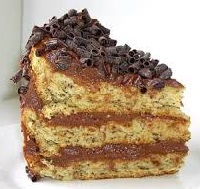 DIOS
TORTE (from Rosemarie Schadle)
DIOS
TORTE (from Rosemarie Schadle)